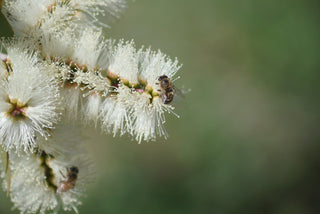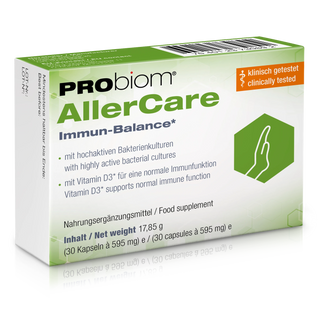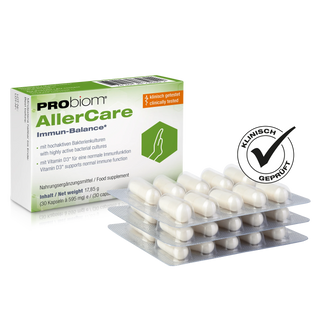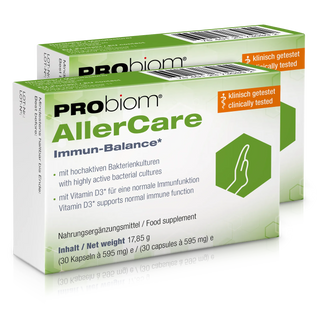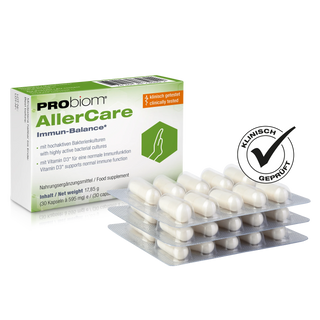Allergies are among the most common health problems of our time. Whether it's hay fever, dust mite allergy, or allergic reactions to pet hair, sufferers are familiar with the typical symptoms: a runny nose, watery eyes, constant sneezing, and a reduced quality of life. One of the most commonly used active ingredients for such complaints is loratadine , a newer-generation antihistamine. But in recent years, an exciting field has opened up: the supplementation of conventional therapies with probiotics , particularly the bacterial strain Lactobacillus paracasei LP-33 . In this article, you'll learn all about loratadine, its effects, possible side effects, and how probiotics can effectively support treatment.
What is loratadine?
Loratadine is a second-generation antihistamine. It blocks the effects of histamine, a chemical messenger released during allergic reactions. Histamine is responsible for swelling of mucous membranes, a runny nose, and watery eyes. By inhibiting the effects of histamine, loratadine alleviates these typical allergy symptoms.
A major advantage of loratadine is that, unlike older antihistamines, it rarely causes drowsiness. This makes it particularly suitable for people who want to remain functional in everyday life despite their allergy.
Areas of application of loratadine
Loratadine is mainly used for:
-
Hay fever (seasonal allergic rhinitis)
-
House dust allergy (perennial allergic rhinitis)
-
Hives (urticaria)
-
Allergic reactions to animal hair or pollen
It's especially effective if you start taking it before the allergy season begins. This can often alleviate or even prevent symptoms altogether.
How does loratadine work in the body?
When allergy sufferers come into contact with pollen or other allergens, the body releases histamine. This histamine binds to specific receptors (H1 receptors), triggering allergic symptoms. Loratadine blocks precisely these H1 receptors, preventing histamine from taking effect.
The effect usually occurs within one to three hours after ingestion and lasts up to 24 hours. Therefore, one tablet per day is usually sufficient.
Side effects of loratadine
Although loratadine is generally well tolerated, side effects may occur in rare cases. These include:
-
Headache
-
nervousness
-
Gastrointestinal complaints
-
Fatigue (rare)
However, compared to older antihistamines, these side effects are significantly less frequent and less pronounced.
Probiotics and allergies – why this is exciting
In recent years, interest in probiotics has grown rapidly. These are "good" bacteria that support our immune system and can help regulate inflammation. They are familiar from foods like yogurt and sauerkraut, but are also available in the form of dietary supplements.
Their potential role in allergies is particularly exciting. Allergies often arise from an overreaction of the immune system. Probiotics could intervene to regulate this and "calm" the immune system.
Lactobacillus paracasei LP-33 – the probiotic star for allergies
A specific strain, Lactobacillus paracasei LP-33 , has demonstrated its effectiveness in a large clinical trial called the GA2LEN study (“Efficacy and safety of the probiotic Lactobacillus paracasei LP-33 in allergic rhinitis: a double-blind, randomized, placebo-controlled trial”). The goal was to determine whether LP-33 can improve the symptoms of allergic rhinitis—and whether it is particularly effective when used in conjunction with loratadine.
The GA2LEN study at a glance:
-
Participants: Over 400 patients with hay fever
-
Method: Double-blind, randomized, placebo-controlled
-
Treatment: One group received Lactobacillus paracasei LP-33, one group received loratadine alone, another group received the combination of both, and one group received a placebo.
-
Results: The combination of LP-33 and loratadine showed the best results. Symptoms were significantly less severe, and quality of life improved the most compared to the other groups.
-
Safety: No relevant side effects – the probiotic was very well tolerated.
The study suggests that Lactobacillus paracasei LP-33 not only works on its own, but can even enhance the effects of loratadine . This opens up a new approach: the combination of conventional medication and probiotic support. Read our article "Lactobacillus paracasei LP-33 – Probiotic Support for Allergies with Scientific Backing ."
Combination of loratadine and probiotics
The exciting question now is: Can the effect of loratadine be enhanced by probiotics?
Research—especially the GA2LEN study—suggests that both approaches can complement each other well. Loratadine has a short-term effect, directly blocking allergic symptoms. Probiotics such as Lactobacillus paracasei LP-33, on the other hand, have a longer-term effect by regulating the immune system and reducing the overall tendency to allergies. Together, they can relieve acute symptoms more quickly and sustainably.
This means that while loratadine alleviates acute symptoms, probiotics can modulate the underlying causes and enhance the effects of loratadine. A combination of these could therefore help allergy sufferers react less strongly to allergens and have an overall better quality of life.
Comparison: Loratadine alone vs. combination with probiotics
| Form of therapy | Effect | Duration of effect | Advantages | Disadvantages |
|---|---|---|---|---|
| Only loratadine | Fast symptom relief by blocking histamine | Lasts up to 24 hours | Simple, well-tolerated, non-drowsy | Only symptomatic, no change in the immune system |
| Probiotics only (LP-33) | Regulates the immune system in the long term, reduces allergy symptoms | Effect begins after about 2-4 weeks | Natural, safe, good study situation | No immediate effect |
| combination | Immediate symptom control + long-term improvement of the immune system, enhanced effect of loratadine | Short- and long-term effects | Holistic approach, better quality of life | Higher costs, regular intake required |
Conclusion
Loratadine is a proven and well-tolerated allergy medication. It reliably relieves symptoms and enables sufferers to manage their daily lives despite their allergies. But allergies are more than just annoying symptoms—they are a manifestation of an overactive immune system.
This is where probiotics come into play: Lactobacillus paracasei LP-33, in particular , was shown in a large study to provide long-term relief from allergic symptoms. Combined with loratadine, this offers an exciting approach: rapid symptom relief from loratadine, long-term immune system support from probiotics—and enhanced effectiveness of both combined.
This could be a real benefit for allergy sufferers – and an indication that the future of allergy therapy lies in a combination of classical and modern approaches.
Frequently Asked Questions (FAQ)
Does loratadine make you drowsy?
Not usually. Loratadine belongs to the second generation of antihistamines, which barely penetrate the central nervous system. Therefore, fatigue rarely occurs.
Can you take loratadine long-term?
Yes, in consultation with your doctor, loratadine can be taken throughout allergy season. It is considered safe.
What is special about Lactobacillus paracasei LP-33?
LP-33 is a probiotic that has been shown in studies to reduce allergic symptoms, especially in combination with loratadine.
Why does the combination of loratadine and LP-33 work better?
Because both act on different levels: Loratadine blocks acute symptoms, while LP-33 regulates the immune system long-term. Together, they reinforce each other.
Are there any side effects of LP-33?
No relevant side effects have been identified so far. It is considered very well tolerated.
How long does it take for LP-33 to work?
Probiotics take time. The effect usually occurs after a few weeks of regular use.
Do you need to take LP-33 after allergy season?
This depends on the individual's course. Many experts recommend taking the medication beyond the season to keep the immune system stable.
Do I get LP-33 in every probiotic?
No, LP-33 is a specific strain. You have to specifically look for preparations that contain it.

